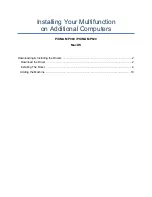
406
Step Command
Remarks
3.
Configure
subnet-leased users.
•
Configure an IPv4 subnet-leased
user:
ip subscriber subnet-leased ip
ip-address
{
mask
|
mask-length
}
username
name
password
{
ciphertext
|
plaintext
}
string
[
domain
domain-name
]
•
Configure an IPv6 subnet-leased
user:
ipv6 subscriber subnet-leased
ipv6 ipv6-address prefix-length
username
name
password
{
ciphertext
|
plaintext
}
string
[
domain
domain-name
]
By default, no subnet-leased user
is configured.
Configuring L2VPN-leased users
You can configure one L2VPN-leased user on an interface on an L2VPN network. An L2VPN-leased
user carries IPv4 and IPv6 traffic from hosts.
On a Layer 3 Ethernet subinterface, the IPoE L2VPN-leased user is mutually exclusive with the
subinterface rate statistics collection feature. For more information about subinterface rate statistics
collection, see
Interface Configuration Guide
.
To configure an L2VPN-leased user:
Step Command
Remarks
1.
Enter system view.
system-view
N/A
2.
Enter interface view.
interface interface-type
interface-number
N/A
3.
Configure an
L2VPN-leased user.
ip subscriber l2vpn-leased
username
name
password
{
ciphertext
|
plaintext
}
string
[
domain
domain-name
]
By default, no L2VPN-leased
user is configured.
Configuring ISP domains for leased users
The BRAS selects ISP domains for leased users in the following order:
•
Domains configured for each interface-leased user and each subnet-leased user
•
Service-specific domain
•
Domain configured for leased users
•
Default system domain
For more information about domains configured for each interface-leased user and each
subnet-leased user, see "
Configuring interface-leased users
" and "
," respectively. For more information about how to configure service-specific ISP domains, see
Configuring service-specific ISP domains
." For more information about how to configure the default
system domain, see "
To configure ISP domains for leased users:
Step Command
Remarks
1.
Enter system view.
system-view
N/A
















































